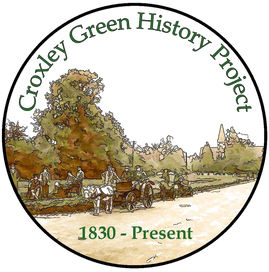John Sharpey-Schäfer 1881-1918

John’s parents Edward and Maud (néé Dixey) lived in Oakland, Borehamwood/ Elstree, Hertfordshire, where four of their five children were born, including John, who was born on the 29th June and baptised on the 30th July 1881 in the Elstree parish church.
Between 1887-1891 Edward, Maud and the children moved to Little Gillions, The Green, Croxley Green. The U.K. census for the year 1891 (taken on the 5th April) shows Edward aged 40, Maud aged 31, Marjory aged 10, John aged 9, and Geraldine Mary aged 4. Records confirm John was educated at Ascham House, Bournemouth, Dorset.
Between 1887-1891 Edward, Maud and the children moved to Little Gillions, The Green, Croxley Green. The U.K. census for the year 1891 (taken on the 5th April) shows Edward aged 40, Maud aged 31, Marjory aged 10, John aged 9, and Geraldine Mary aged 4. Records confirm John was educated at Ascham House, Bournemouth, Dorset.
John’s father, a Physiologist, became increasingly busy travelling and accepting many lecturing opportunities, as well as publishing the results of his investigative work.
During 1891, Edward and Maud travelled to Scotland, probably to confirm the acceptance of a new position Edward had been offered at the University of Edinburgh. The Scottish census returns also for 1891 (5th April) show that during their visit Edward and Maud were living at 19 Coates Gardens, St Georges, Edinburgh, Midlothian. Whilst they were at this address John’s youngest brother, Thomas Sydney Herman Schäfer, was born on 20th May 1891. When they returned to Croxley Green, he was baptised at All Saints church, Croxley Green, on the 25th July 1891 by Rev Astley Roberts.
According to John’s naval records he enrolled on 15th July 1895 (just after his 14th birthday) as a naval cadet on H.M.S. Britannia, the training academy for naval officers in Dartmouth in Devon.
During 1891, Edward and Maud travelled to Scotland, probably to confirm the acceptance of a new position Edward had been offered at the University of Edinburgh. The Scottish census returns also for 1891 (5th April) show that during their visit Edward and Maud were living at 19 Coates Gardens, St Georges, Edinburgh, Midlothian. Whilst they were at this address John’s youngest brother, Thomas Sydney Herman Schäfer, was born on 20th May 1891. When they returned to Croxley Green, he was baptised at All Saints church, Croxley Green, on the 25th July 1891 by Rev Astley Roberts.
According to John’s naval records he enrolled on 15th July 1895 (just after his 14th birthday) as a naval cadet on H.M.S. Britannia, the training academy for naval officers in Dartmouth in Devon.
Sadly, his mother Maud died the following year on 6th October 1896. She was just 37 years old. A service was held at All Saints church by the Rev Astley Roberts, followed by the interment at the Chorleywood Road Cemetery. Maud’s death was widely reported and there were many relatives and friends in attendance.
In 1899 John’s father was offered the position of Chair of Physiology at the University of Edinburgh, and in 1900 he was elected a Fellow of the Royal Society of Edinburgh. On 10th October 1900, Edward remarried. His bride was Ethel Maude Roberts, niece of Rev. Astley Roberts, vicar of All Saints church, Croxley Green.
Edward's new appointment probably prompted the family to leave Croxley Green. The Scottish census for 1901 shows Edward, Ethel Maude and Edward’s son Thomas aged 9 years, at school, as well as three servants, again living at 19, Coates Gardens, St Georges, Edinburgh, West Coates, Midlothian. (The U.K. census for Little Gillions shows the house is occupied by another family.) In 1902 Edward commissioned the Scottish architect Robert Lorimer to design a new family home, Marly Knowe, a substantial Arts and Crafts villa in the coastal town of North Berwick, East Lothian, Scotland.
In 1901 naval records show that John, aged 19, was now at the Royal Naval College in Greenwich as a Sub Lieutenant. Having been upgraded from a cadet to midshipman he had previously served on H.M.S. Bonaventure, on the China Station, an important base for projecting power in this area. He subsequently served as Sub-Lieutenant in home waters, and when promoted again he became Lieutenant on the Indian Station. He was engaged in various expeditions connected with the suppression of the slave trade and the illicit importation of arms on the Somaliland coast and in the Persian Gulf.
In 1901 naval records show that John, aged 19, was now at the Royal Naval College in Greenwich as a Sub Lieutenant. Having been upgraded from a cadet to midshipman he had previously served on H.M.S. Bonaventure, on the China Station, an important base for projecting power in this area. He subsequently served as Sub-Lieutenant in home waters, and when promoted again he became Lieutenant on the Indian Station. He was engaged in various expeditions connected with the suppression of the slave trade and the illicit importation of arms on the Somaliland coast and in the Persian Gulf.
In 1907 he was appointed as Naval Research Assistant in the Hydrographic Department of the Admiralty. This was a specialist job producing specific geographical oceanic charts and tables for assisting mariners navigating at sea.
The same year on 9th November, John married Ruth Hutchison at St. Mary Abbotts Church, Kensington. Ruth was the youngest daughter of William Marshal and Elizabeth Annabella Hutchison. Although she was born in 1884 in Jersey, Channel Islands, by 1891 the family had moved to Heronsgate, Rickmansworth, but then by 1901 they had moved again to Shanklin on the Isle of Wight. Ruth’s father was a Scottish composer of choral and piano music.
The same year on 9th November, John married Ruth Hutchison at St. Mary Abbotts Church, Kensington. Ruth was the youngest daughter of William Marshal and Elizabeth Annabella Hutchison. Although she was born in 1884 in Jersey, Channel Islands, by 1891 the family had moved to Heronsgate, Rickmansworth, but then by 1901 they had moved again to Shanklin on the Isle of Wight. Ruth’s father was a Scottish composer of choral and piano music.
John and Ruth’s son Edward Peter was born 22nd September 1908 and a second son John Michael on 18th October 1911. During that year John was on board HMS Hearty.
At his own request, in 1912 John retired as Lieutenant Commander. In May of that year the family moved to Malacca, Malaysia where he became a planter on the Devon Estate rubber plantation.
However, at the onset of WW1 in 1914 John re-enlisted in the navy and was initially appointed as part of the Staff of the Admiralty, in command of the China Station at Singapore. This was the senior department for operational planning, policy and strategy. In January 1915 he was appointed to the flagship H.M.S. King George V, a dreadnought battleship of the 2nd Battle Squadron, and was involved in the Battle of Jutland that took place on 31st May, 1916.
However, at the onset of WW1 in 1914 John re-enlisted in the navy and was initially appointed as part of the Staff of the Admiralty, in command of the China Station at Singapore. This was the senior department for operational planning, policy and strategy. In January 1915 he was appointed to the flagship H.M.S. King George V, a dreadnought battleship of the 2nd Battle Squadron, and was involved in the Battle of Jutland that took place on 31st May, 1916.
He was promoted Acting Commander and Navigator on the Staff soon after this engagement and was instrumental in introducing improvements in tactics that were adopted by the Admiralty. In November 1917, he was selected for special surveying service, and temporarily appointed to H.M.S. Gaillardia in connection with the establishment of the Great Northern Barrage Mine Field between Scotland and Norway. The aim was to interrupt the passage of German U-boats into the North Atlantic which was causing a huge loss of British ships carrying evacuees to America and Canada as well as food supplies to Britain.
On 22nd March 1918, in the North Sea, off the Orkney Islands whilst carrying out operations, it is believed the ship was blown up and sunk by one of the barrage mines. Although most sources put her loss down to mines, at least one suggests the ship was torpedoed by a German U-boat.
John was 36 years old and is commemorated on the Chatham Naval Memorial, Kent, Panel 27, as well as the St. Baldreds church memorial, North Berwick.
His name is also on a memorial at Christ Church, Red Square, Malacca.
His name is also on a memorial at Christ Church, Red Square, Malacca.
John’s wife Ruth, still only 35, remarried in 1920 to Philip Agnew Bateman-Champain. He was 46, a widower, and a retired Naval Captain.
John’s brother Thomas Sydney Herman also enlisted as soon as the war began and was promoted as Lieutenant in the 13th Northumberland Fusiliers. He was killed in France on the 26th September 1915.
John’s father Edward was knighted in 1913 and with Ethel Maude became Sir Edward and Lady Sharpey-Schäfer.
See https://www.croxleygreenhistory.co.uk/edward_schafer.html
John’s brother Thomas Sydney Herman also enlisted as soon as the war began and was promoted as Lieutenant in the 13th Northumberland Fusiliers. He was killed in France on the 26th September 1915.
John’s father Edward was knighted in 1913 and with Ethel Maude became Sir Edward and Lady Sharpey-Schäfer.
See https://www.croxleygreenhistory.co.uk/edward_schafer.html
Information taken from to following-:
https://wellcomecollection
www.findmypast.co.uk/Family/History
www.Ancestry.co.uk
https://www.findmypast.co.uk/search-newspapers
www.ancestry.com/
https://livesofthefirstworldwar.iwm.org.uk/lifestory/6900346
http://www.hertsatwar.co.uk/biographies/862592/john-sharpey-schafer
[email protected]
http://roll-of-honour.com/Overseas/malaccaww1.html
https://wellcomecollection
www.findmypast.co.uk/Family/History
www.Ancestry.co.uk
https://www.findmypast.co.uk/search-newspapers
www.ancestry.com/
https://livesofthefirstworldwar.iwm.org.uk/lifestory/6900346
http://www.hertsatwar.co.uk/biographies/862592/john-sharpey-schafer
[email protected]
http://roll-of-honour.com/Overseas/malaccaww1.html





















